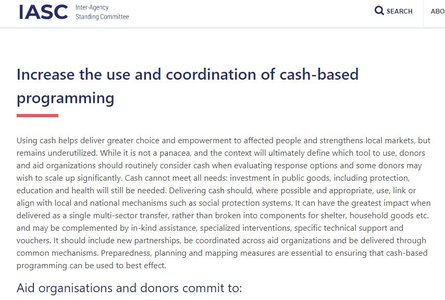
Using cash helps deliver greater choice and empowerment to affected people and strengthens local markets, but remains underutilized. While it is not a panacea, and the context will ultimately define which tool to use, donors and aid organizations should routinely consider cash when evaluating response options and some donors may wish to scale up significantly. Cash cannot meet all needs: investment in public goods, including protection, education and health will still be needed. Delivering cash should, where possible and appropriate, use, link or align with local and national mechanisms such as social protection systems. It can have the greatest impact when delivered as a single multi-sector transfer, rather than broken into components for shelter, household goods etc. and may be complemented by in-kind assistance, specialized interventions, specific technical support and vouchers. It should include new partnerships, be coordinated across aid organizations and be delivered through common mechanisms. Preparedness, planning and mapping measures are essential to ensuring that cash-based programming can be used to best effect.